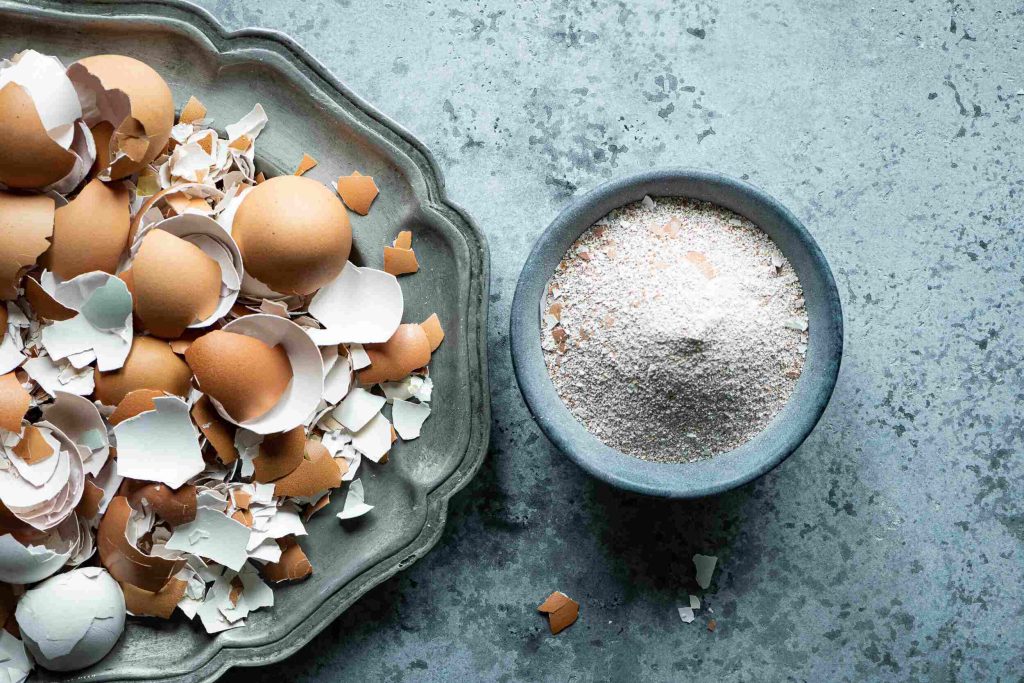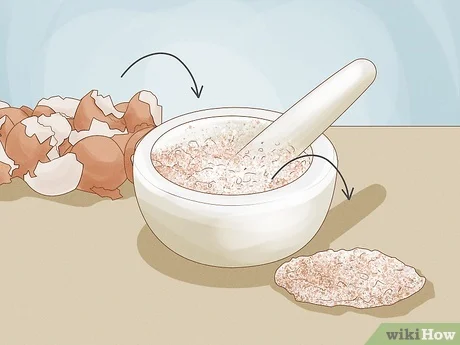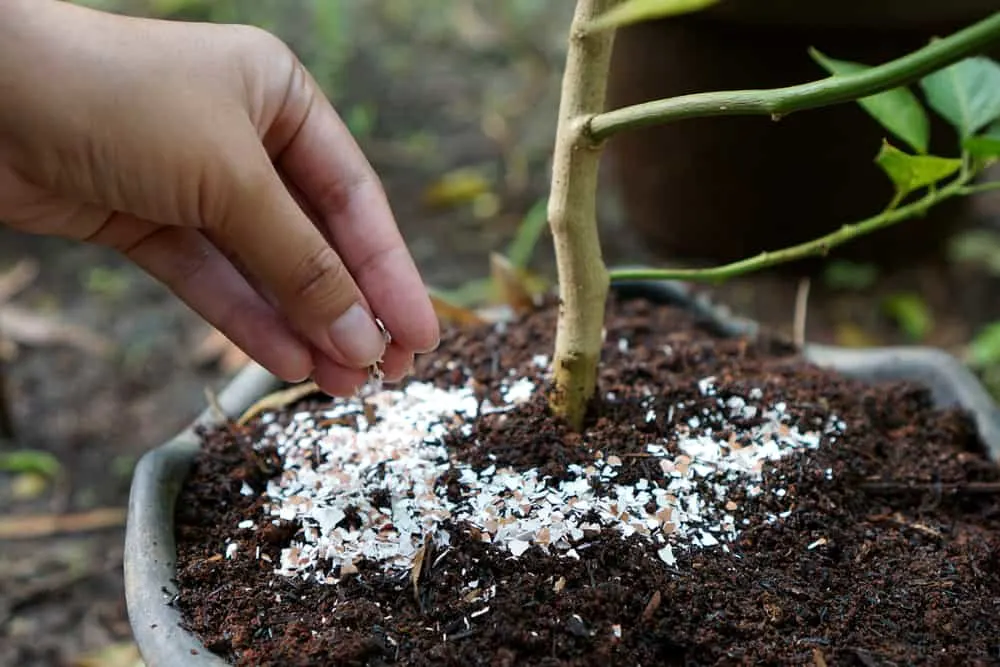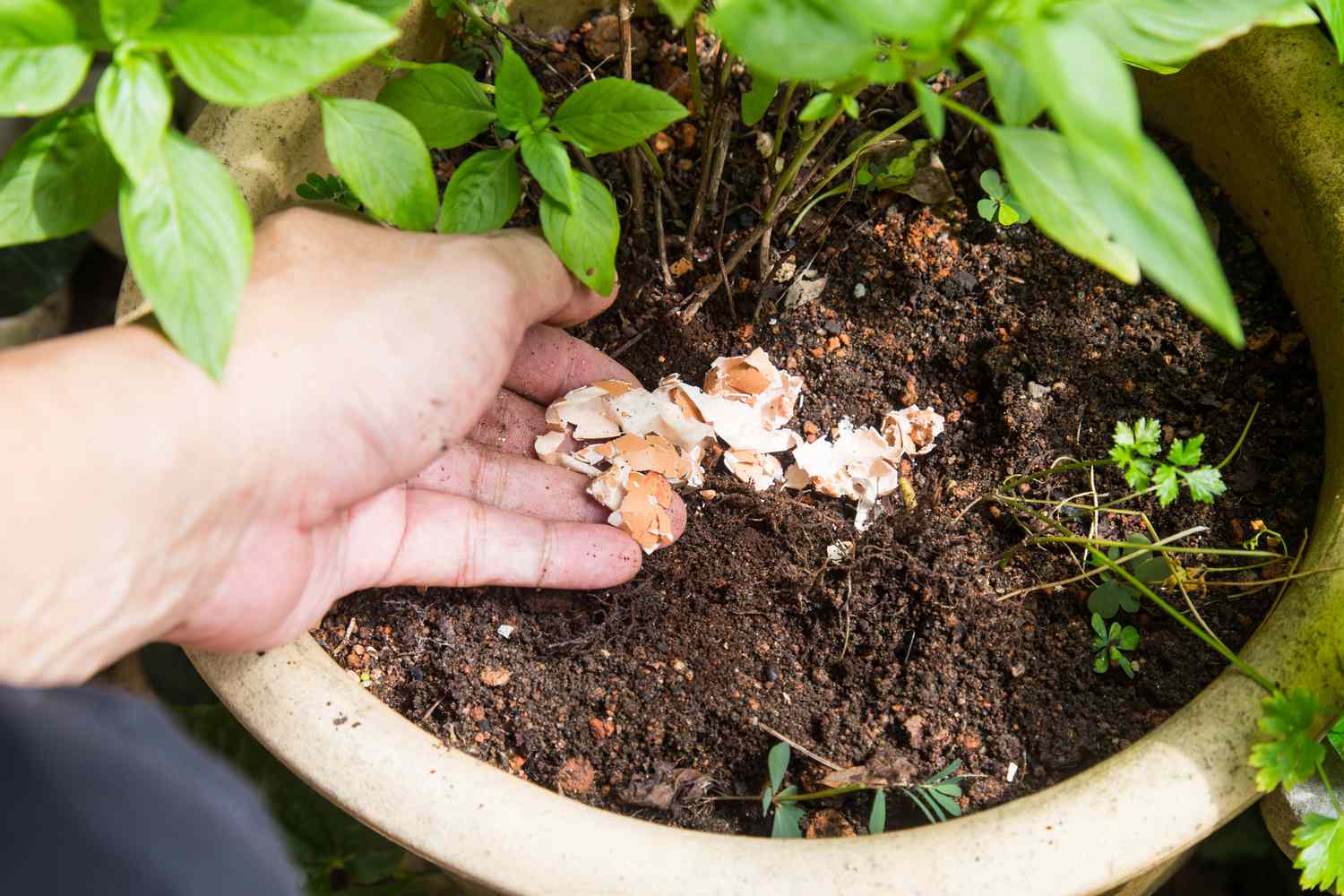Are your indoor plants looking a little lackluster? Do you find yourself constantly reaching for store-bought fertilizers, wondering if there’s a more natural and cost-effective solution? The secret to vibrant, healthy houseplants might be hiding in your kitchen: eggshells.
While often discarded as waste, eggshells are a valuable source of nutrients, particularly calcium, which plays a crucial role in plant growth. This comprehensive guide will delve into the science-backed benefits of using eggshells as fertilizer, providing you with practical, step-by-step instructions for preparing and applying them to your indoor plants.
The Science Behind Eggshells as Fertilizer
Eggshells are often overlooked as a fertilizer, but their nutrient profile and benefits make them an excellent choice for indoor gardening. By understanding the science behind their impact, you can make informed decisions about incorporating them into your plant care routine.
Key Nutrients in Eggshells
Eggshells are primarily composed of calcium carbonate, a vital nutrient for plants. Calcium plays a crucial role in:
- Strengthening cell walls, which helps plants maintain their structure and resist diseases.
- Supporting root development for efficient nutrient uptake.
- Improving soil structure by reducing compaction and enhancing aeration.
In addition to calcium, eggshells contain trace amounts of other minerals like magnesium and potassium, which contribute to overall plant health. These nutrients are released gradually, making eggshells a slow-release fertilizer that nourishes your plants over time.
Why Eggshells Are Safer Than Synthetic Fertilizers
Unlike synthetic fertilizers, which can cause nutrient imbalances or harm sensitive plants, eggshells are gentle and natural. They provide a steady supply of calcium without the risk of over-fertilizing, making them particularly suitable for indoor plants, which often have limited soil volume.

Eco-Friendly Benefits
Using eggshells as fertilizer is not just good for your plants—it’s good for the planet. Instead of discarding eggshells as kitchen waste, you can repurpose them to enrich your soil. This reduces household waste and supports sustainable gardening practices, aligning with the growing trend of eco-conscious living.
By integrating eggshell fertilizer into your indoor plant care routine, you’re making a choice that benefits your plants, the environment, and your wallet.
Best Indoor Plants to Use Eggshell Fertilizer
Not all indoor plants have the same nutrient needs, so understanding which plants benefit most from eggshell fertilizer can help you make the most of this natural resource. Eggshells are particularly useful for plants that thrive on calcium and other trace minerals. Here are some top picks for your indoor garden:
1. Plants That Love Calcium
- Tomatoes and Peppers (Indoor Varieties): These fruiting plants have a high demand for calcium, as it helps prevent issues like blossom end rot and supports healthy fruit development.
- Succulents and Cacti: Calcium strengthens their cell walls, making these drought-tolerant plants even hardier.
- Ferns: Ferns benefit from the slow release of calcium, which supports their lush, green foliage.
2. Herbs and Edible Plants
- Basil, Parsley, and Mint: These commonly grown indoor herbs flourish with the steady supply of calcium and minerals from eggshell fertilizer. They become more robust and produce flavorful leaves.
- Leafy Greens (Spinach and Lettuce): While often grown outdoors, these plants can thrive indoors with adequate calcium to support their rapid growth.
3. Flowering Indoor Plants
- African Violets: These delicate flowers benefit from the extra calcium for healthy blooms and vibrant leaves.
- Jasmine and Gardenias: Flowering plants like these often show improved bud formation and bloom longevity with regular calcium supplementation.
Plants to Be Cautious With
While eggshell fertilizer is gentle, not all plants require the same nutrients. For instance, carnivorous plants like Venus flytraps prefer nutrient-poor soil, so they won’t benefit from added calcium. Similarly, some tropical plants with specific pH preferences may react poorly to excessive calcium.
Maximizing Benefits
To ensure your plants thrive, pair eggshell fertilizer with a balanced indoor gardening routine. Use it as a supplemental boost alongside other organic fertilizers and adjust based on the specific needs of your plants.
How to Prepare Eggshell Fertilizer for Indoor Plants?
Using eggshells as a fertilizer might seem straightforward, but proper preparation ensures that your plants can benefit fully from their nutrient content. Here’s a detailed, step-by-step guide to help you prepare and use eggshell fertilizer effectively for your indoor plants.
Step 1: Collect and Clean the Eggshells
Begin by collecting eggshells from your kitchen. Rinse them thoroughly under running water to remove any residual egg white or yolk. This step is crucial to prevent foul odors and avoid attracting pests to your plants. For best results, let the shells air dry completely after washing.
Step 2: Dry the Eggshells
Once cleaned, spread the eggshells on a tray or plate in a well-ventilated area. Allow them to dry for a day or two. Alternatively, you can bake them at a low temperature (around 200°F or 90°C) for 10-15 minutes to speed up the process. Baking also makes the shells brittle and easier to crush.
Step 3: Crush or Grind the Eggshells
After drying, crush the eggshells into smaller pieces using your hands or a rolling pin. For a finer texture, use a blender or food processor to grind them into a powder. Finely ground eggshells release nutrients faster, which is particularly beneficial for smaller indoor pots with limited soil volume.

Step 4: Apply the Eggshell Fertilizer
- Direct Application: Sprinkle the crushed or powdered eggshells evenly onto the soil surface of your indoor plants. Gently mix it into the top layer of soil to help it integrate and release nutrients gradually.
- Eggshell Tea: For faster results, create a liquid fertilizer by boiling crushed eggshells in water (use about 10-12 shells for 1 liter of water). Let the mixture steep overnight, then strain and use the nutrient-rich water to hydrate your plants.
Pro Tips from Windy Sprouts
- Moderation is Key: Avoid over-applying eggshell fertilizer, as too much calcium can alter the soil’s pH balance and affect nutrient absorption.
- Pair with Soil Testing: Conduct a soil pH test before adding eggshells. This ensures your plants’ soil conditions are optimal for calcium absorption.
- Layering for Compost: If you maintain a compost bin, you can add crushed eggshells as part of your organic waste to create a balanced nutrient mix.
Common Mistakes to Avoid When Using Eggshell Fertilizer
While eggshell fertilizer is a fantastic natural option for indoor plants, improper use can reduce its effectiveness or even harm your plants. By understanding and avoiding these common mistakes, you can ensure that your plants receive the full benefits of this eco-friendly solution.
1. Skipping the Cleaning and Drying Process
One of the most frequent mistakes is neglecting to clean and dry the eggshells thoroughly before use. Residual egg white can attract pests, create foul odors, and introduce bacteria to your plants. Always wash the shells thoroughly and let them dry completely before application.
2. Using Whole Eggshells Instead of Crushing Them
Applying whole eggshells to your soil may seem convenient, but it significantly slows the nutrient release process. Crushed or powdered eggshells break down more quickly, ensuring that calcium and minerals are readily available for your plants. Grinding the shells into a fine powder is especially effective for indoor pots with limited soil volume.
3. Overusing Eggshell Fertilizer
Too much of a good thing can backfire. Over-applying eggshell fertilizer can lead to an imbalance in the soil’s pH, potentially locking out other essential nutrients. Stick to moderate amounts, applying only once every few months or as needed.
4. Ignoring Soil pH and Plant Needs
Not all plants or soil types benefit equally from eggshell fertilizer. Acid-loving plants like azaleas and philodendrons may not thrive with added calcium, as it can raise the soil pH. Conducting a soil test before applying eggshell fertilizer helps you tailor its use to your plant’s specific needs.
5. Expecting Instant Results
Eggshell fertilizer is a slow-release option, meaning it takes time to break down and deliver nutrients. Avoid the mistake of expecting immediate visible changes in your plants. Consistent, long-term use yields the best results.
6. Overlooking Proper Storage
If you prepare eggshell powder in bulk, storing it improperly can lead to contamination or loss of effectiveness. Always keep it in a dry, airtight container to preserve its quality.
Pro Tip for Success
If you’re new to using eggshell fertilizer, start small. Apply it to one or two plants and monitor their progress before scaling up to your entire indoor garden. This approach allows you to observe how your plants respond and adjust your routine if necessary. By avoiding these common pitfalls, you can harness the full potential of eggshell fertilizer and ensure that your indoor plants thrive.
Benefits of Eggshell Fertilizer for Sustainable Indoor Gardening
Eggshell fertilizer isn’t just a natural way to nourish your plants; it’s also a step toward eco-friendly and sustainable indoor gardening. Let’s explore why incorporating this method into your plant care routine is a win for your plants, your wallet, and the environment.

1. Reduces Kitchen Waste
By repurposing eggshells as fertilizer, you’re turning what would otherwise be discarded as kitchen waste into a valuable resource. This small habit contributes to reducing landfill waste, aligning with sustainable living practices.
2. Supports Long-Term Plant Health
Eggshell fertilizer’s slow-release nature provides your indoor plants with a steady supply of calcium and trace minerals. This continuous nourishment strengthens plant cell walls, supports healthy root systems, and promotes overall resilience. Over time, your plants become more robust and better equipped to thrive in an indoor environment.
3. Environmentally Friendly Alternative to Synthetic Fertilizers
Unlike chemical fertilizers that may harm soil health or pollute water sources, eggshells are completely natural and biodegradable. They enrich the soil without introducing harmful chemicals, making them a safe and sustainable option for your indoor garden.
4. Cost-Effective Solution
Fertilizers can be a recurring expense, but eggshell fertilizer is essentially free. By using something you already have in your kitchen, you save money while still providing your plants with essential nutrients.
5. Enhances Soil Quality
Eggshells improve the texture and aeration of your soil, particularly when finely ground and mixed into the soil. Better soil structure promotes healthy root growth and efficient water absorption, crucial for indoor plants with limited soil space.
6. Encourages Sustainable Gardening Practices
Incorporating eggshell fertilizer into your routine is a small yet impactful step toward greener gardening practices. It’s an opportunity to connect with your plants and adopt habits that align with eco-conscious values.
FAQs About Eggshell Fertilizer for Indoor Plants
1. How often should I use eggshell fertilizer?
Eggshell fertilizer is a slow-release nutrient source, so you don’t need to apply it frequently. A good rule of thumb is to mix eggshell powder into your potting soil every 1–2 months, depending on your plants’ growth rate and calcium requirements. For plants in smaller pots, use smaller quantities to avoid over-fertilizing.
2. Can eggshells replace all other fertilizers?
No, eggshells cannot completely replace other fertilizers. While they’re an excellent source of calcium and trace minerals, they lack nitrogen, phosphorus, and potassium—the primary nutrients plants need for robust growth. To ensure balanced nutrition, use eggshells as a supplement alongside other organic fertilizers or compost.
3. Should I bake eggshells before using them as fertilizer?
Baking eggshells is optional but recommended. Heating the shells at a low temperature (around 200°F or 100°C) for 10–15 minutes sterilizes them, eliminates odors, and makes them easier to grind into a fine powder. This process ensures that your fertilizer is safe and effective for your plants.
4. Can I mix eggshells with other organic fertilizers?
Absolutely! Combining eggshells with other organic fertilizers like compost, coffee grounds, or banana peels creates a nutrient-rich mix tailored to your plants’ needs. This approach enhances soil quality and provides a broader spectrum of essential nutrients. Just ensure the combination doesn’t disrupt the soil’s pH balance, especially for plants with specific pH preferences.
Final Thoughts on Eggshell Fertilizer for Indoor Plants
Eggshell fertilizer is a sustainable, cost-effective way to nourish your indoor plants. By repurposing eggshells, you not only reduce waste but also provide essential nutrients like calcium, promoting healthier roots, leaves, and overall plant growth.
For the best results, ensure you clean, dry, and crush the eggshells properly. Tailoring the application to your plants’ needs helps you avoid common mistakes and boosts their health.
This simple, eco-friendly practice is a step toward sustainable living, showing how small actions can create big impacts. Whether you’re a beginner or seasoned gardener, eggshell fertilizer is a natural, reliable way to help your plants thrive. Give it a try, and watch your indoor garden flourish!

